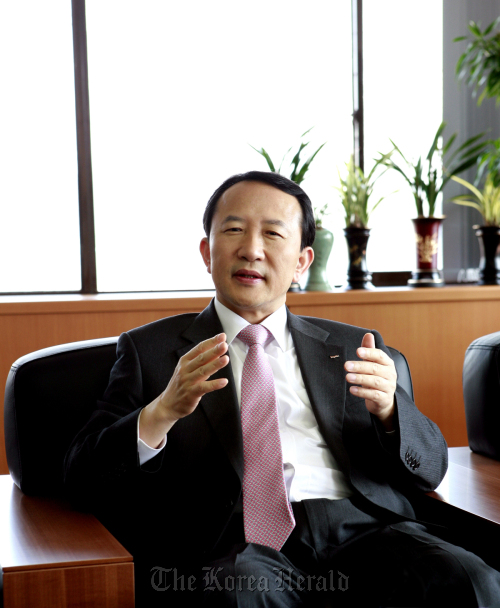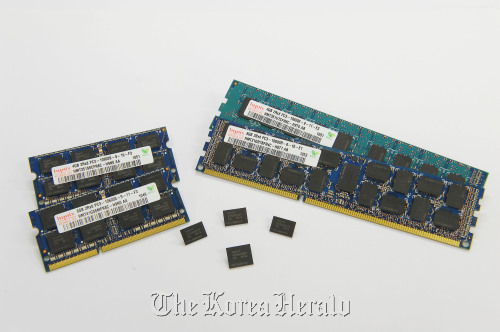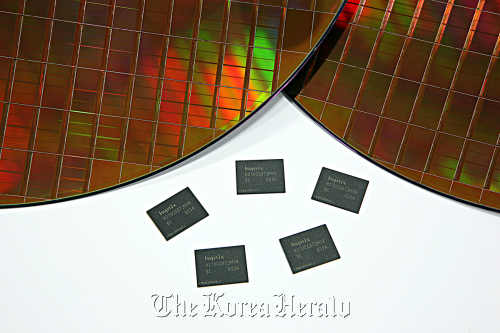Memory chipmaker looks to growth in non-PC sector including mobile, graphic, server DRAM
Hynix Semiconductor Inc., the world’s second-largest maker of computer memory chips, looks to new growth opportunities in specialty products in the premium market.
The company’s premium product line-up in the non-PC sector, which includes mobile, graphic and server dynamic random access memory (DRAM), is expected to account for about 70 percent of sales this year, up from 60 percent in 2010 and 50 percent in 2009.
“Hynix has been steadily increasing the portion of specialty products moving a step further from its product line-up of DRAM for PCs,” a Hynix official said. “Specialty DRAM is not only more expensive than the PC DRAM, but it could produce a stable profit (for the company) because of the comparatively low price volatility.”
Kwon Oh-chul, chief executive of Hynix, also told reporters earlier this year that it would put its focus on producing premium chips in the non-PC sector in an effort to widen the gap with other firms. The premium product requires more advanced technology than PC DRAM, increasing the entry barrier, said company officials.
Hynix Semiconductor Inc., the world’s second-largest maker of computer memory chips, looks to new growth opportunities in specialty products in the premium market.
The company’s premium product line-up in the non-PC sector, which includes mobile, graphic and server dynamic random access memory (DRAM), is expected to account for about 70 percent of sales this year, up from 60 percent in 2010 and 50 percent in 2009.
“Hynix has been steadily increasing the portion of specialty products moving a step further from its product line-up of DRAM for PCs,” a Hynix official said. “Specialty DRAM is not only more expensive than the PC DRAM, but it could produce a stable profit (for the company) because of the comparatively low price volatility.”
Kwon Oh-chul, chief executive of Hynix, also told reporters earlier this year that it would put its focus on producing premium chips in the non-PC sector in an effort to widen the gap with other firms. The premium product requires more advanced technology than PC DRAM, increasing the entry barrier, said company officials.

The movement takes place after Hynix reached a record 12.09 trillion won ($10.87 billion) in consolidated sales last year, up by 53 percent from 2009, despite the price fall of two major memory chips ― DRAM and NAND Flash memory.
DRAM is the most common kind of random access memory for personal computers and workstations and NAND Flash memory is a non-volatile storage technology which does not need power to retain data.
The company also posted its operating profit at 3.27 trillion won, an increase of 1,605 percent from 192 billion won recorded in 2009.
Its net income also amounted to 2.66 trillion won in 2010, up from the loss of 333 billion won in the previous year.
On top of that, it invested a total of 3.38 trillion won last year, a higher figure than the 2.3 trillion won investment it has planned earlier in the year.
Company officials said the generation-ahead technology leadership and profitable product portfolio, which includes mobile, graphic and server DRAM, were the main contributors to the high sales, operating profit and net income.
Hynix’s mobile DRAM, for example, enables the wireless device to perform better by adding speed when working with the software. It also reportedly lowers the gadget’s power consumption.

Currently, about 60 percent of Hynix’s entire DRAM production is composed of 2 Gigabit memory chips, which are mostly used for smartphones. It further plans to lead the premium market by rolling out 4 Gigabit products mainly for netbooks and mobile Internet devices that are more energy-saving and better performing, according to company officials.
For NAND Flash memory products, it began mass producing 64-Gigabit NAND Flash using 20-nanometer class technology last August, advancing from the previous 32-Gigabit. The 20-nanometer NAND Flash memory offers a 60 percent increase in productivity compared to the 30-nanometer class technology.

“Listening to the different demands of our customers, we were able to develop a 64 Gigabit product, which are maximized and customized for a particular group,” said a Hynix official.
S.W. Park, executive vice president and chief technology officer at the company, said Hynix’s decision to mass produce the 20-nano class 64 Gigabit chips will allow the firm “to provide customized, high performance products in a timely manner which perfectly suits mobile solutions like smartphones and tablet PCs.”
It formed a strategic alliance with Anobit, an Israeli NAND-based solution provider, to combine its technology and the Israeli firm’s controller devices for some NAND Flash solution products.
The top tier memory semiconductor supplier also increased the percentage of 30-nano and 20-nano NAND Flash memory products to over 85 percent as of last year in a bid to strengthen its business competitiveness.
On a related front, Hynix also announced earlier that it made an agreement with the U.S.-based Hewlett-Packard to jointly develop “memristor” ― a shortened term for memory resistor ― technology in a next-generation memory product called resistive random access memory (ReRAM).
The two firms will together commercialize the innovative memristor technology from research. ReRAM holds the potential to replace Flash memory currently used in devices like mobile phones and serves as a universal storage medium, meaning it could function like Flash memory and DRAM as well as a computer hard drive, its officials said.
Hynix’s technology chief Park said the company expects to deliver new energy-efficient products to customers through the deal. Its partner Stan Williams of HP said the agreement combines HP’s core intellectual property with a first-rate supplier that has the capacity for the innovation to enter the market for world-class memory on a mass scale.
By Cho Ji-hyun (sharon@heraldcorp.com)









![[Kim Seong-kon] Democracy and the future of South Korea](http://res.heraldm.com/phpwas/restmb_idxmake.php?idx=644&simg=/content/image/2024/04/16/20240416050802_0.jpg&u=)







![[KH Explains] Hyundai's full hybrid edge to pay off amid slow transition to pure EVs](http://res.heraldm.com/phpwas/restmb_idxmake.php?idx=652&simg=/content/image/2024/04/18/20240418050645_0.jpg&u=20240418181020)

![[Today’s K-pop] Zico drops snippet of collaboration with Jennie](http://res.heraldm.com/phpwas/restmb_idxmake.php?idx=642&simg=/content/image/2024/04/18/20240418050702_0.jpg&u=)